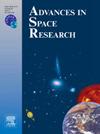The effect of solar activity on the ionosphere in the southern hemisphere’s MSNA region
IF 2.8
3区 地球科学
Q2 ASTRONOMY & ASTROPHYSICS
引用次数: 0
Abstract
Ionospheric empirical models have worse accuracy in describing the Mid-latitude Summer Night Anomaly (MSNA). MSNA variations are mainly affected by solar activity. The study uses GPS TEC data, CODE TEC data, and solar activity index data, applying time series and correlation analyses, to study the effects of different solar activities on the ionosphere in the southern hemisphere MSNA region. Results show that: (1) the MSNA phenomenon in the Southern Hemisphere usually occurs in January–February and November–December, and mainly occurs in the region of (60°S–70°S, 80°W–120°W), and the degree of longitudinal changes in its range is more prominent than that of latitudinal changes during the occurrence of MSNA. (2) The TEC usually reaches its maximum before midnight in years with low solar activity, and the number of days on which the TEC reaches its maximum before midnight is more than the number of days on which it reaches its maximum after midnight. (3) The MSNA index shows a low degree of linear correlation with the solar activity F10.7 index, with a correlation coefficient of only –0.20.
太阳活动对南半球MSNA区域电离层的影响
电离层经验模式在描述中纬度夏夜异常(MSNA)时精度较差。MSNA的变化主要受太阳活动的影响。利用GPS TEC数据、CODE TEC数据和太阳活动指数数据,应用时间序列和相关分析,研究了不同太阳活动对南半球MSNA地区电离层的影响。结果表明:(1)南半球MSNA现象通常发生在1 - 2月和11 - 12月,主要发生在(60°S - 70°S, 80°W - 120°W)区域,在MSNA发生期间,其范围内的纵向变化程度比纬向变化更为突出。(2)在太阳活动较弱的年份,TEC通常在午夜前达到最大值,且在午夜前达到最大值的天数多于午夜后达到最大值的天数。(3) MSNA指数与太阳活动F10.7指数呈低线性相关,相关系数仅为-0.20。
本文章由计算机程序翻译,如有差异,请以英文原文为准。
求助全文
约1分钟内获得全文
求助全文
来源期刊

Advances in Space Research
地学天文-地球科学综合
CiteScore
5.20
自引率
11.50%
发文量
800
审稿时长
5.8 months
期刊介绍:
The COSPAR publication Advances in Space Research (ASR) is an open journal covering all areas of space research including: space studies of the Earth''s surface, meteorology, climate, the Earth-Moon system, planets and small bodies of the solar system, upper atmospheres, ionospheres and magnetospheres of the Earth and planets including reference atmospheres, space plasmas in the solar system, astrophysics from space, materials sciences in space, fundamental physics in space, space debris, space weather, Earth observations of space phenomena, etc.
NB: Please note that manuscripts related to life sciences as related to space are no more accepted for submission to Advances in Space Research. Such manuscripts should now be submitted to the new COSPAR Journal Life Sciences in Space Research (LSSR).
All submissions are reviewed by two scientists in the field. COSPAR is an interdisciplinary scientific organization concerned with the progress of space research on an international scale. Operating under the rules of ICSU, COSPAR ignores political considerations and considers all questions solely from the scientific viewpoint.
 求助内容:
求助内容: 应助结果提醒方式:
应助结果提醒方式:


